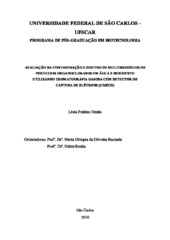Avaliação da contaminação e destino de multirresíduos de pesticidas organoclorados em água e sedimento utilizando cromatografia gasosa com detector de captura de elétrons (CG/ECD)
Resumen
The use of pesticides for the purpose of improving agricultural productivity during the last century, played a key role in environmental contamination especially in surface water and sediment. Pesticides used on a large scale are the organochlorines, which, once present in the soil can be transported in large quantities by the rain, mainly reaching surface water. This study aimed to evaluate the contamination of water in the River Basin Monjolinho mutirressíduos by organochlorine pesticides, through physical, chemical, and also using gas chromatography with electron capture detector (GC / ECD) for detection of organochlorine compounds . Therefore, we sampled water and sediment at five points along the River Basin Monjolinho. The method presented achieved Imitating of detection (LOD) of 0.0039 to 0.86 mg L-1, limit of quantification (LOQ) of 0.07 to 2.59 mg L-1 and determination coefficient of 0.99. Through the results of chromatographic analysis, physico-chemical water and sediment, we found the presence of organochlorine compounds in all sampling points, a fact which may be related to persistent use of these compounds near the basin. These results support the view that the organochlorine pesticides are still part of the products used in agriculture of our country and also that the proposed methodology for the determination of organochlorine compounds multiressíduos is profitable and satisfactory.
